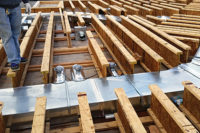Do you make cold calls? “Never.”
Do you advertise?“It’s expensive. Besides, it’s pointless.”
Train service technicians to sell?“Absolutely out of the question.”
Sell on price? “You’ve got to be kidding.”
Call him unconventional, unorthodox, or even a bit mad, but no matter how one describes his methods, Koch’s results are remarkable. In the three short years since entering the hvac business, he has become the leading salesman of one manufacturer’s variable-speed heating-cooling equipment in the Midwest.
More importantly, this self-described “variable-speed chauvinist” has carved out a high-margin residential niche for his employer, AA Service Co., Northbrook, Ill.
With a corporate sales and marketing background in computer systems, Koch came to the hvac business “uncorrupted” by conventional industry sales practices which, in his view, limit profits and leave customers less than completely satisfied.
Koch states that “Every businessman has to ask himself, ‘How much money do I want to take home at the end of the day?’ I knew that if we could provide our customers with a system that far surpasses their expectations, then we could build a high-margin business, based chiefly on referrals and repeats, that leaves us with more money at the end of the day.”
For Koch and AA Service, surpassing expectations requires an ultimate-comfort system. Such a system includes a high-quality installation of high-performance components such as a two-stage furnace, variable-speed blower, humidifier, high-efficiency air cleaner, and zone controls.
Don't count the customer's money
When Koch first arrived at AA Service, he raised a few eyebrows by declaring a permanent moratorium on low-ball pricing. The idea was to avoid business where quality standards might be violated.Accordingly, every bid that goes out on any job, low end or high end, is priced to reflect the highest quality standards. The point is to avoid the commodity-like products and installations completely, because they don’t serve the goal of building a base of long-term customers.
The irony is that Koch realizes his highest-margin business in the aftermath of the low-service pricing. He invariably finds his best and most profitable customers are those who have been under-served by the low bidder.
“Ninety percent of our business is retrofit,” he says. “Many times I’ll be called to a newer house because they’re having comfort problems and I’ll wind up replacing the whole system.”
What Koch has discovered is that many customers gladly pay for the added comfort and quiet of an ultimate-comfort system once they become aware of it. That’s why every quote goes out with a range of options, from bare bones to a complete, state-of-the-art hvac system with all the bells and whistles cited previously.
“So many of my competitors make the mistake of assuming that customers, whether they are middle or upper class, can’t or won’t pay for higher quality. We simply present our customers with options and let them choose. That’s why our motto is, ‘Don’t count the customer’s money.’”
Cultivating the referral tree
And how do the customers feel about being given the opportunity to buy a high-end system? Koch points to a file of unsolicited letters from customers who rave about the product and service. He asserts that people wouldn’t bother to write unless the job far exceeded their expectations.AA Service has clearly taken the long view when it comes to building its business, because in the long run it is far more profitable. Koch estimates that one good customer is worth $35,000 over time because of repeat business and referrals.
“It’s far more profitable to keep one good customer than it is to get a new one,” he says. “Think of it like a family tree, with hundreds of people springing from one couple. The difference is, we don’t have to wait five generations.”
Koch also points out that the referral tree has the potential to grow in both positive and negative ways. “If you do a good job, they tell four or five people. If you do a lousy job, they tell everybody.”
After one season with an ultimate-comfort system, an AA Service customer remarked, “I can’t believe I lived in this house for 20 years with my old system,” referring to the noise and discomfort it produced.
After a season with his new furnace, this customer was directly responsible for his neighbor buying a complete variable-speed heating-cooling system, which in turn led to three other sales in the same neighborhood.
This reaction is typical, says Koch, especially in retrofit situations where customers have long experience with a system of lesser quality.
Word-of-mouth advertising works very well with general contractors as well. AA Service does a great deal of remodeling and renovation work in neighborhoods like Lincoln Park, where 100-year-old, four-story, brick row houses present substantial challenges for running proper ductwork.
“I’m not the low bidder; I’m the only bidder,” says Koch, referring to working relationships he’s established with several high-end general contractors.
“These guys have very demanding customers who want the best and we provide it without fail. As a result, we do all their mechanical work.”
Like other customers, those referred by a general contractor are given a choice of systems and, if necessary, a list of a half-dozen other homeowners in the area that AA Service has worked for. Most often it is endorsements from other customers and the contractor that persuade these new customers to make the investment in a better system.
Strict separation of sales and service
In a recent letter, a customer raved about the quiet operation of the GE ECM blower motor and how his heat-distribution problems were eliminated by the new ductwork and two-stage gas furnace.He was especially taken with the courtesy and craftsmanship of the installers. Never had he seen such meticulous work done by such conscientious workers, he said.
Visits to AA Service’s residential installations reveal signs of painstaking work, such as straight, clean, well-crafted duct runs with flawless joints that don’t require duct tape to be airtight. Such attention to detail produces tidy installations and, more importantly, a proper one that all but eliminates call backs.
“Our chief complaint is that the system is too quiet,” says Koch. “People don’t think it’s working.”
Similarly, when employees go on a service call, they take great care to do a thorough job performing routine maintenance or diagnosing a problem. Then they take time to communicate the diagnosis to the customer.
If, and only if, the customer wants a quote does the service technician call in a salesman.
The contractor focuses on selling the competence of its service techs, who function both as craftsmen and educators. These techs attempt to explain how things work in layman’s terms, and what can be done to remedy a problem.
One of the communication tools they use is a booklet called “Decorating with Comfort.” It is available free from GE, and offers customers a primer to variable-speed systems and their benefits.
“If they read that booklet before I make my sales call, it’s pretty much in the bag,” says Koch. “Everybody who reads it wants [an ultimate-comfort system].”
Don't ask for the sale
So how does Koch sell face to face? While many of his techniques are traditional, he seems to break a couple of well-established rules.First, he budgets a fair amount of time for an interview with a prospective customer. Even though they may only be interested in a new furnace filter, for example, he will ask them a variety of questions about comfort: air distribution, noise, temperature fluctuations, and stratification, as well as humidity and dust control.
If there are technical questions beyond his ken, he will have a service technician assess the situation before making any recommendations to the customer.
For example, AA Service is especially concerned with achieving proper airflow so that the system performs as expected. Once he feels confident that the mechanical system can do the job, Koch meets with the customer to make his presentation.
“The most important thing I do is educate the customer,” he says. “An ultimate-comfort system requires time and enthusiasm to get across.”
The first thing he covers is constant airflow. The fact that the system can silently and inexpensively move air between cycles to lessen temperature stratification and reduce airborne dust is a hit with just about every customer. “I can’t make that happen without proper airflow.”
Following constant airflow is generally a discussion of the merits of a two-stage furnace. Customers are taken with the idea of a system that can more precisely maintain a setpoint on the thermostat. This is accomplished with help of the low-fire setting on the furnace which operates about 70% to 80% of the time, and the ECM blower motor that automatically and efficiently delivers the right amount of airflow in low or high fire.
Koch finds more customers are health conscious and ask questions about indoor air quality. To address these concerns, he elaborates on the benefits of the combination of a high-efficiency air cleaner, fresh-air heat exchanger, and constant fan. Customers are generally receptive.
“I’m very careful not to make health claims,” he says. “But I know that prospects who contact previous customers hear anecdote after anecdote about fewer colds and allergy symptoms with this equipment. I leave it at that.”
To the many apparent benefits of variable-speed systems, Koch adds a healthy dose of genuine enthusiasm for his product. In his view, it is one of the most important factors in the sales equation which can be expressed thus:
Competent technicians + meticulous installations + strong referrals + enthusiasm for the product = sales
There is one more thing. “I was always taught in business school to ask for the sale. Well, I don’t do that. I think it just makes customers uncomfortable, so the less I do of that, the more I believe I sell.”
Just one more irony. Somehow, it shouldn’t come as a surprise.






